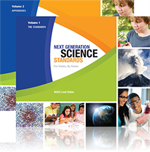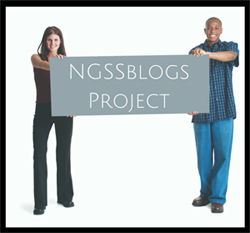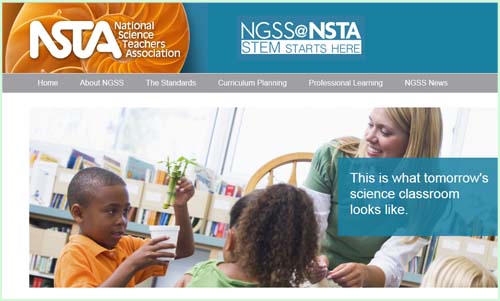The Next Generation Science Standards: a transformational opportunity
By Guest Blogger
Posted on 2015-01-15
 The Next Generation Science Standards (NGSS) and A Framework for K–12 Science Education articulate a beautiful vision for students. The overarching goal of the standards is a coherent and rigorous science education for all students, enabling them to be critical consumers of science and attain the scientific literacy necessary to be informed citizens able to engage in public discourse and decision making on issues of science, engineering, and technology. For those who are so inspired, attaining proficiency in the standards provides students with the foundation needed to pursue STEM careers (a much-needed cohort in our society). Whereas the vision is clear, there is no single path teachers can follow to implement the Next Generation Science Standards. K–12 teachers who want to play a central role in transforming science teaching and learning need guidance in creating paths along which they can translate the NGSS into strong curricula and inspired instruction.
The Next Generation Science Standards (NGSS) and A Framework for K–12 Science Education articulate a beautiful vision for students. The overarching goal of the standards is a coherent and rigorous science education for all students, enabling them to be critical consumers of science and attain the scientific literacy necessary to be informed citizens able to engage in public discourse and decision making on issues of science, engineering, and technology. For those who are so inspired, attaining proficiency in the standards provides students with the foundation needed to pursue STEM careers (a much-needed cohort in our society). Whereas the vision is clear, there is no single path teachers can follow to implement the Next Generation Science Standards. K–12 teachers who want to play a central role in transforming science teaching and learning need guidance in creating paths along which they can translate the NGSS into strong curricula and inspired instruction.
So, how can teachers build aligned NGSS curricula and instruction? Through individual reflection and productive struggle; conversation and collaboration with science educators nationwide; and partnerships with national, state, and local supporters, teachers can develop and implement a shared vision for classroom teaching and learning in science.
Reflection
 Groups of teachers all over the United States are finding the path to NGSS less daunting when they actively engage in adult learning through reflection on how their new approaches to science teaching are working and are mindful when reviewing resources for implementation. There is always that temptation to look for the easy answers about “How to do the NGSS.” But following someone else’s plans without thoughtful reflection, analysis, and debate will not enable us to reach our own understanding. Without our own deep understanding, we cannot truly shift our classrooms in a sustained way to the deep thinking and critical perspectives required in NGSS. As authors Eric Brunsell, Deb M. Kneser, and Kevin J. Niemi so effectively state in one of my favorite new resources, Introducing Teachers and Administrators to the NGSS, “the NGSS represents an evolution of our understanding of the standards, not a complete break with the past.”
Groups of teachers all over the United States are finding the path to NGSS less daunting when they actively engage in adult learning through reflection on how their new approaches to science teaching are working and are mindful when reviewing resources for implementation. There is always that temptation to look for the easy answers about “How to do the NGSS.” But following someone else’s plans without thoughtful reflection, analysis, and debate will not enable us to reach our own understanding. Without our own deep understanding, we cannot truly shift our classrooms in a sustained way to the deep thinking and critical perspectives required in NGSS. As authors Eric Brunsell, Deb M. Kneser, and Kevin J. Niemi so effectively state in one of my favorite new resources, Introducing Teachers and Administrators to the NGSS, “the NGSS represents an evolution of our understanding of the standards, not a complete break with the past.”
If we develop a deep understanding of the NGSS and build our capacity as teachers to coach students toward independent thinking and lifelong learning, we will be able to use many of our own resources by making revisions and shifts in design, and we will be able to develop our own skills as critical consumers of new resources. The productive struggle of “figuring it out” for ourselves with support from others is what leads to deep understanding. We already know this to be true for our students, so shouldn’t we apply the same principles to our own learning? What could we build together if we applied this thinking to ourselves when it comes to NGSS?
Conversation and Collaboration
 The NGSS is an opportunity for us to collaborate and have conversations around a national common language. One place I like to find support for my own reflection is the NGSSblogs Project. We started this to elevate the collective conversation, so teachers can build paths to NGSS implementation resulting in empowerment for both teachers and students. Just as we witness in our own classrooms, discourse moves understanding forward. I urge you to share your NGSS experiences, have conversations with the teacher down the hall, in the next district, on the other side of the state. Collaborate with those teachers by sharing your best lesson and work together to braid it into the NGSS. Learn from each other and together. The reflection required for sharing powers your own growth while making your reflections public moves the thinking and learning of others. Imagine the resources we could compile if teachers shared what was working (and not working) with NGSS implementation in their own classrooms? By building together, we can assemble an ever-evolving resource bank of NGSS support. Here are some opportunities for conversation, collaboration, and sharing:
The NGSS is an opportunity for us to collaborate and have conversations around a national common language. One place I like to find support for my own reflection is the NGSSblogs Project. We started this to elevate the collective conversation, so teachers can build paths to NGSS implementation resulting in empowerment for both teachers and students. Just as we witness in our own classrooms, discourse moves understanding forward. I urge you to share your NGSS experiences, have conversations with the teacher down the hall, in the next district, on the other side of the state. Collaborate with those teachers by sharing your best lesson and work together to braid it into the NGSS. Learn from each other and together. The reflection required for sharing powers your own growth while making your reflections public moves the thinking and learning of others. Imagine the resources we could compile if teachers shared what was working (and not working) with NGSS implementation in their own classrooms? By building together, we can assemble an ever-evolving resource bank of NGSS support. Here are some opportunities for conversation, collaboration, and sharing:
- NGSS Multi Tools Online Community of Teachers
- NGSSPeer Learning Network on Google Plus
- #NGSSchat on Twitter
Partnerships with Classroom Supporters
If the reflection and collaboration supports our deep understanding of the NGSS and opportunities to learn and share together, how can we collectively determine a sense of what is “good enough”? How can we ensure we have quality resources, models, and unit progressions for NGSS teaching and learning? Through partnerships and community support, we can work together to create models of great classroom teaching and learning. The National Science Teachers Association (NSTA) has been a leader in supporting teachers first in understanding the Next Generation Science Standards themselves and then in understanding how to use the NGSS to transform their science classrooms.
 To help science teachers, NSTA has created the NGSS@NSTA Hub—a one-stop shop for a multitude of resources for teachers to design NGSS instruction for classroom learning. Resources include articles, webinars, videos, models—and coming soon, an interactive database to support teacher collaboration. Tools and resources like these provide support for teachers to collaborate and build instruction and curriculum.
To help science teachers, NSTA has created the NGSS@NSTA Hub—a one-stop shop for a multitude of resources for teachers to design NGSS instruction for classroom learning. Resources include articles, webinars, videos, models—and coming soon, an interactive database to support teacher collaboration. Tools and resources like these provide support for teachers to collaborate and build instruction and curriculum.
Another national supporter, Achieve, Inc., has facilitated work among the 26 lead states in developing the Next Generation Science Standards from the beginning. They continue to support teachers by providing resources and guidance during NGSS implementation. The EQuIP rubric developed by Achieve in a partnership with NSTA, for example, is a tool for determining how closely instructional materials align with the NGSS. An excellent overview on how to use the EQuIP rubric was recently written and gives great advice on How to Select and Design Materials that Align to the Next Generation Science Standards.
Another set of useful tools from Achieve are Evidence Statements. They are a sort of a way to do backwards math—they allow you to visualize the incremental captures of student learning on the path to demonstrating proficiency in performance expectations (PEs). They identify what your lesson is building toward and what still needs to be covered. They provide examples of 3D learning with details on what students should know and be able to do to meet performance expectations. The high school evidence statements have just been released, and middle school and elementary evidence statements are coming soon.
Equipped with all this information and resources, I urge science teachers to remember that they themselves are the most important part of the picture. To reimagine science education, we need more than a set of standards that capture a vision. Teachers are the catalysts for transforming science education; teachers have the practical experience and the day-to-day connections with students to make this happen. National partners like NSTA and Achieve are ready to support us. It is the work of classroom teachers and those who support classroom learning that makes the vision come to fruition. Please become part of the work of building the kind of classroom experience that originally inspired us to become teachers—make your classroom a place of discovery and wonder that leads to investigating the world and building students understanding of the world. The NGSS gives us an opportunity to share our voice, passion, and gifts on a state and national level to help transform science education. What can you contribute to transform science classrooms to support science literacy so we can ensure those we teach today are ready for tomorrow?
Visit www.NGSSPLN.com for more information about a virtual community that is powered by teachers for teachers and allows you to share your talents by becoming part of the conversation.
 Tricia Shelton is a High Science Teacher and Teacher Leader with a BS in Biology and MA in Teaching, who has worked for 19 years in Kentucky driven by a passion to help students develop critical and creative thinking skills. Tricia is a 2014 NSTA Distinguished Teaching Award winner for her contributions to and demonstrated excellence in Science Teaching. As a Professional Learning Facilitator and NGSS Implementation Team Leader, Tricia has worked with educators across the United States to develop Best Practices in the Science and Engineering classroom through conference presentations, webinars, coordinating and co- moderating #NGSSchat on Twitter, and virtual and face to face PLC work. Tricia’s current Professional Learning Facilitation includes work around the Next Generation Science Standards and helping STEM students develop the 21st Century Skills of critical and creative thinking, collaboration and communication (including Social media and Video) and Project-Based Learning. Since 2011, she has conducted action research in her classroom to develop effective and accessible instructional and assessment strategies incorporating Best Practice in the STEM classroom, including work for the Marzano Research Laboratory. Through a partnership with BenchFly, the premier science video production platform, she works with CEO, Dr. Alan Marnett, to reinvent scientific education and communication with video. Find Shelton on Twitter @TdiShelton.
Tricia Shelton is a High Science Teacher and Teacher Leader with a BS in Biology and MA in Teaching, who has worked for 19 years in Kentucky driven by a passion to help students develop critical and creative thinking skills. Tricia is a 2014 NSTA Distinguished Teaching Award winner for her contributions to and demonstrated excellence in Science Teaching. As a Professional Learning Facilitator and NGSS Implementation Team Leader, Tricia has worked with educators across the United States to develop Best Practices in the Science and Engineering classroom through conference presentations, webinars, coordinating and co- moderating #NGSSchat on Twitter, and virtual and face to face PLC work. Tricia’s current Professional Learning Facilitation includes work around the Next Generation Science Standards and helping STEM students develop the 21st Century Skills of critical and creative thinking, collaboration and communication (including Social media and Video) and Project-Based Learning. Since 2011, she has conducted action research in her classroom to develop effective and accessible instructional and assessment strategies incorporating Best Practice in the STEM classroom, including work for the Marzano Research Laboratory. Through a partnership with BenchFly, the premier science video production platform, she works with CEO, Dr. Alan Marnett, to reinvent scientific education and communication with video. Find Shelton on Twitter @TdiShelton.
The mission of NSTA is to promote excellence and innovation in science teaching and learning for all.
Follow NSTA
| |
|
|
|
Disclaimer: The views expressed in this blog post are those of the author(s) and do not necessarily reflect the official position of the National Science Teaching Association (NSTA).


